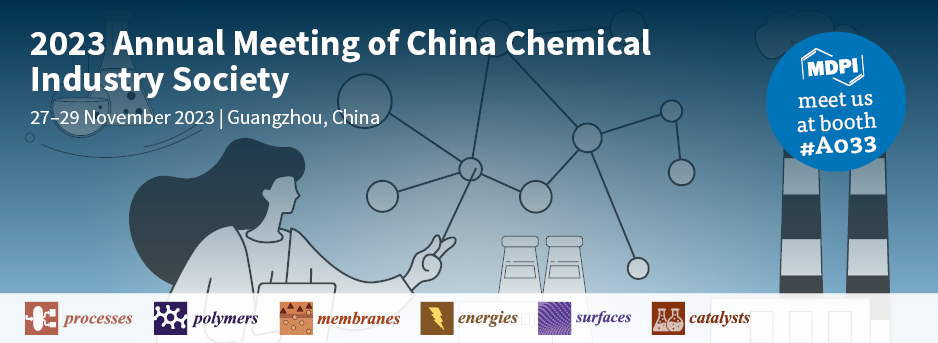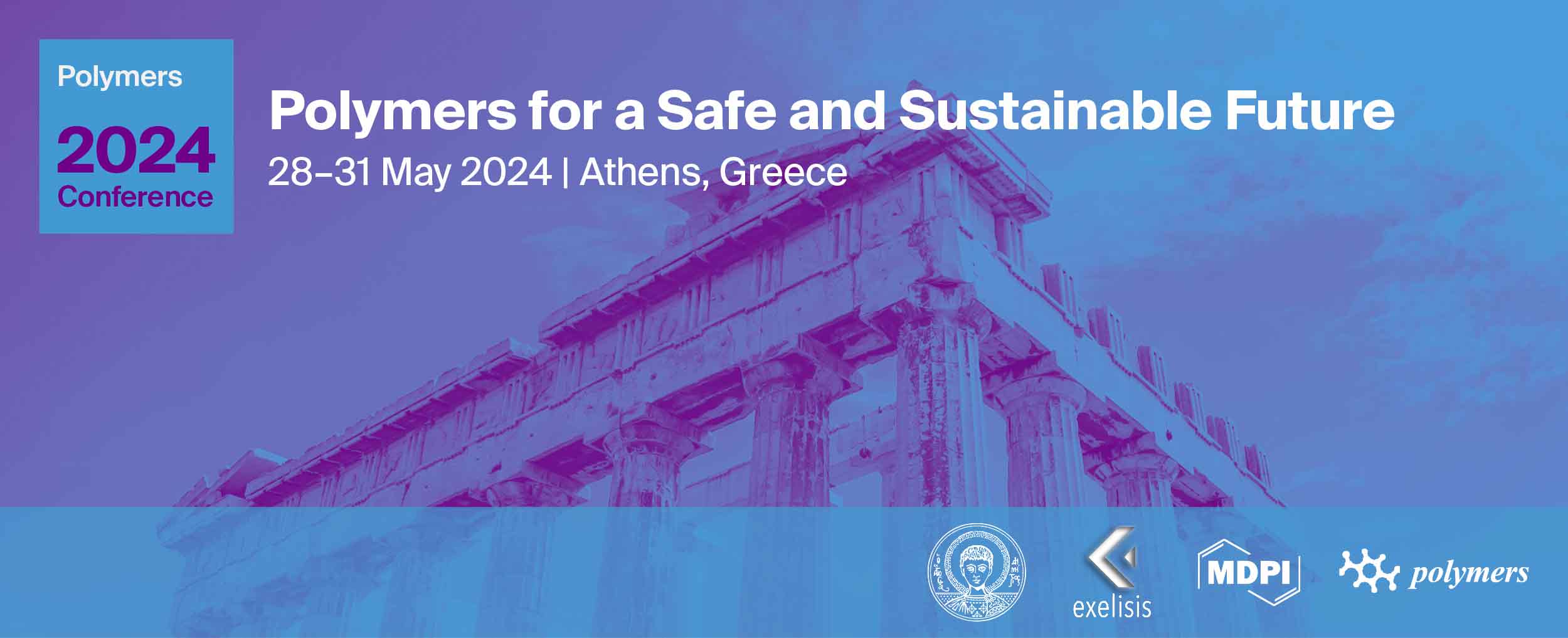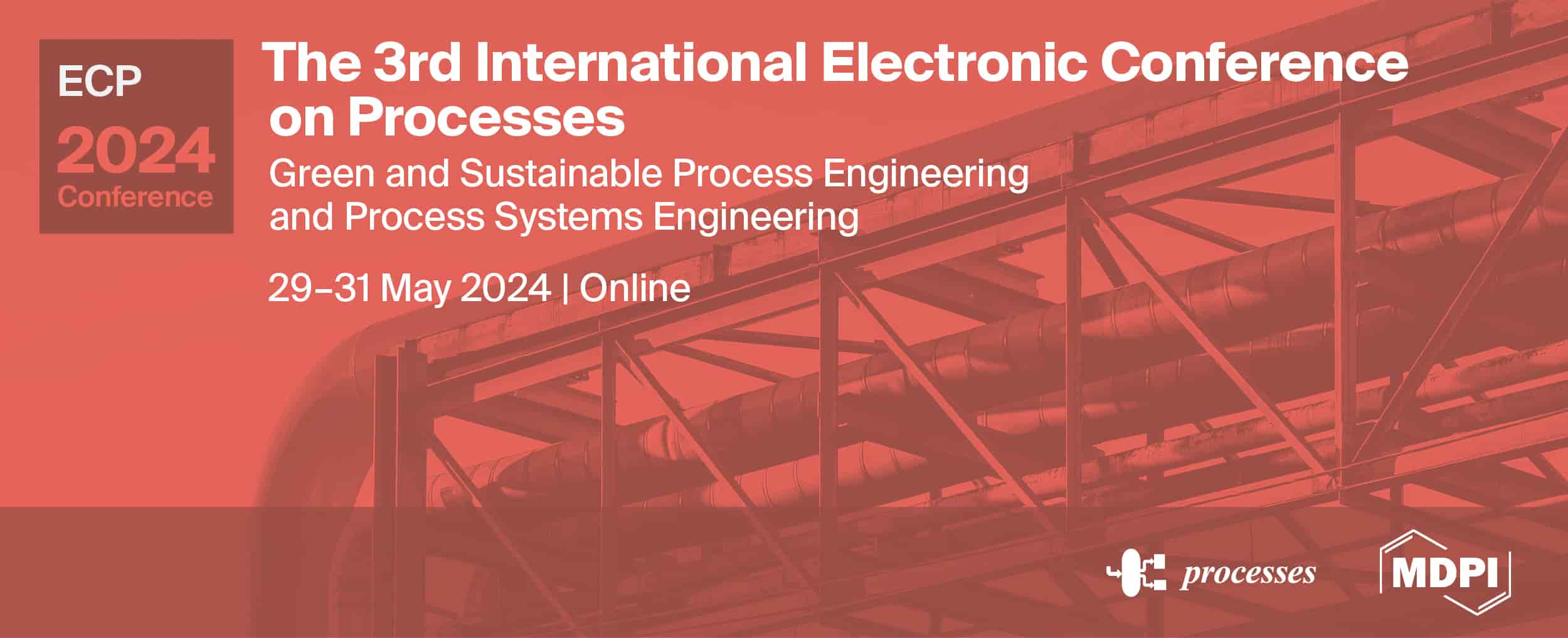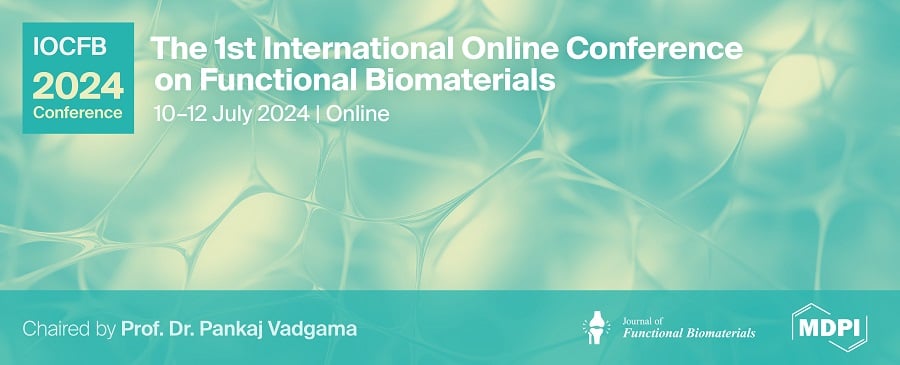-
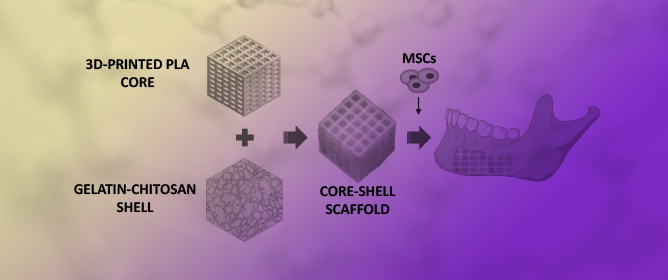 New Poly(lactic acid)–Hydrogel Core–Shell Scaffolds Highly Support MSCs’ Viability, Proliferation and Osteogenic Differentiation
New Poly(lactic acid)–Hydrogel Core–Shell Scaffolds Highly Support MSCs’ Viability, Proliferation and Osteogenic Differentiation -
 Polyhydroxyurethane and Poly(ethylene oxide) Multiblock Copolymer Networks: Crosslinking with Polysilsesquioxane, Reprocessing and Solid Polyelectrolyte Properties
Polyhydroxyurethane and Poly(ethylene oxide) Multiblock Copolymer Networks: Crosslinking with Polysilsesquioxane, Reprocessing and Solid Polyelectrolyte Properties -
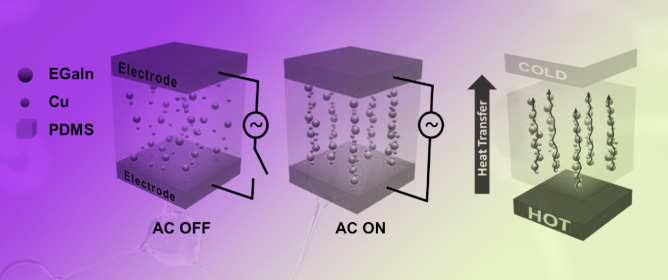 Dielectrophoretic Alignment of Biphasic Metal Fillers for Thermal Interface Materials
Dielectrophoretic Alignment of Biphasic Metal Fillers for Thermal Interface Materials -
 Evaluating the Electromagnetic Shielding of Continuous Carbon Fiber Parts Produced by Additive Manufacturing
Evaluating the Electromagnetic Shielding of Continuous Carbon Fiber Parts Produced by Additive Manufacturing
Journal Description
Polymers
Polymers
is an international, peer-reviewed, open access journal of polymer science published semimonthly online by MDPI. Belgian Polymer Group (BPG), European Colloid & Interface Society (ECIS), National Interuniversity Consortium of Materials Science and Technology (INSTM) and North American Thermal Analysis Society (NATAS) are affiliated with Polymers and their members receive a discount on the article processing charges.
- Open Access— free for readers, with article processing charges (APC) paid by authors or their institutions.
- High Visibility: indexed within Scopus, SCIE (Web of Science), Ei Compendex, PubMed, PMC, FSTA, CAPlus / SciFinder, Inspec, and other databases.
- Journal Rank: JCR - Q1 (Polymer Science) / CiteScore - Q1 (Polymers and Plastics)
- Rapid Publication: manuscripts are peer-reviewed and a first decision is provided to authors approximately 13.7 days after submission; acceptance to publication is undertaken in 2.9 days (median values for papers published in this journal in the second half of 2023).
- Recognition of Reviewers: reviewers who provide timely, thorough peer-review reports receive vouchers entitling them to a discount on the APC of their next publication in MDPI journals, in appreciation of the work.
- Testimonials: See what our authors and editors say about Polymers.
Impact Factor:
5.0 (2022);
5-Year Impact Factor:
5.0 (2022)
Latest Articles
Polymeric Nanoparticles for Biomedical Applications
Polymers 2024, 16(2), 249; https://doi.org/10.3390/polym16020249 (registering DOI) - 15 Jan 2024
Abstract
Polymeric nanoparticles (NPs), utilized extensively in biomedical applications, have received increasing interest in the preceding years and today represent an established part of the nanotechnology field [...]
Full article
(This article belongs to the Special Issue Polymeric Nanoparticles for Biomedical Applications)
Open AccessArticle
Collagen Matrix to Restore the Tympanic Membrane:Developing a Novel Platform to Treat Perforations
by
, , , , , , , , , , , , , , , and
Polymers 2024, 16(2), 248; https://doi.org/10.3390/polym16020248 - 15 Jan 2024
Abstract
Modern otology faces challenges in treating tympanic membrane (TM) perforations. Instead of surgical intervention, alternative treatments using biomaterials are emerging. Recently, we developed a robust collagen membrane using semipermeable barrier-assisted electrophoretic deposition (SBA-EPD). In this study, a collagen graft shaped like a sponge
[...] Read more.
Modern otology faces challenges in treating tympanic membrane (TM) perforations. Instead of surgical intervention, alternative treatments using biomaterials are emerging. Recently, we developed a robust collagen membrane using semipermeable barrier-assisted electrophoretic deposition (SBA-EPD). In this study, a collagen graft shaped like a sponge through SBA-EPD was used to treat acute and chronic TM perforations in a chinchilla model. A total of 24 ears from 12 adult male chinchillas were used in the study. They were organized into four groups. The first two groups had acute TM perforations and the last two had chronic TM perforations. We used the first and third groups as controls, meaning they did not receive the implant treatment. The second and fourth groups, however, were treated with the collagen graft implant. Otoscopic assessments were conducted on days 14 and 35, with histological evaluations and TM vibrational studies performed on day 35. The groups treated with the collagen graft showed fewer inflammatory changes, improved structural recovery, and nearly normal TM vibrational properties compared to the controls. The porous collagen scaffold successfully enhanced TM regeneration, showing high biocompatibility and biodegradation potential. These findings could pave the way for clinical trials and present a new approach for treating TM perforations.
Full article
(This article belongs to the Special Issue Multi-Functional Collagen-Based Biomaterials for Biomedical Applications II)
Open AccessArticle
Specifics of Cryopreservation of Hydrogel Biopolymer Scaffolds with Encapsulated Mesenchymal Stem Cells
by
, , , , and
Polymers 2024, 16(2), 247; https://doi.org/10.3390/polym16020247 - 15 Jan 2024
Abstract
The demand for regenerative medicine products is growing rapidly in clinical practice. Unfortunately, their use has certain limitations. One of these, which significantly constrains the widespread distribution and commercialization of such materials, is their short life span. For products containing suspensions of cells,
[...] Read more.
The demand for regenerative medicine products is growing rapidly in clinical practice. Unfortunately, their use has certain limitations. One of these, which significantly constrains the widespread distribution and commercialization of such materials, is their short life span. For products containing suspensions of cells, this issue can be solved by using cryopreservation. However, this approach is rarely used for multicomponent tissue-engineered products due to the complexity of selecting appropriate cryopreservation protocols and the lack of established criteria for assessing the quality of such products once defrosted. Our research is aimed at developing a cryopreservation protocol for an original hydrogel scaffold with encapsulated MSCs and developing a set of criteria for assessing the quality of their functional activity in vitro. The scaffolds were frozen using two alternative types of cryocontainers and stored at either −40 °C or −80 °C. After cryopreservation, the external state of the scaffolds was evaluated in addition to recording the cell viability, visible changes during subsequent cultivation, and any alterations in proliferative and secretory activity. These observations were compared to those of scaffolds cultivated without cryopreservation. It was shown that cryopreservation at −80 °C in an appropriate type of cryocontainer was optimal for the hydrogels/adipose-derived stem cells (ASCs) tested if it provided a smooth temperature decrease during freezing over a period of at least three hours until the target values of the cryopreservation temperature regimen were reached. It was shown that evaluating a set of indicators, including the viability, the morphology, and the proliferative and secretory activity of the cells, enables the characterization of the quality of a tissue-engineered construct after its withdrawal from cryopreservation, as well as indicating the effectiveness of the cryopreservation protocol.
Full article
(This article belongs to the Special Issue Advances in Biopolymers and Composites for Biomedical Applications)
►▼
Show Figures
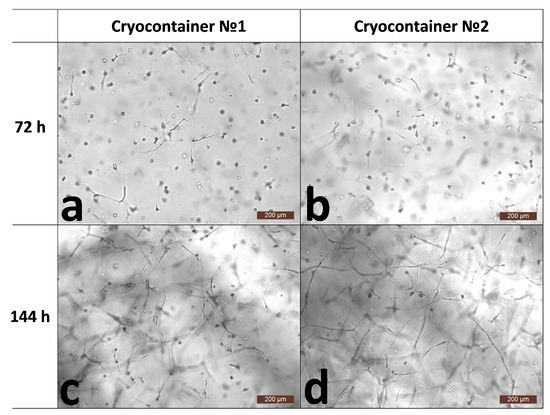
Figure 1
Open AccessArticle
Catalyst-Free Amino-Yne Click Reaction: An Efficient Way for Immobilizing Amoxicillin onto Polymeric Surfaces
by
, , , , and
Polymers 2024, 16(2), 246; https://doi.org/10.3390/polym16020246 - 15 Jan 2024
Abstract
Surface modifications play a crucial role in enhancing the functionality of biomaterials. Different approaches can be followed in order to achieve the bioconjugation of drugs and biological compounds onto polymer surfaces. In this study, we focused on the immobilization of an amoxicillin antibiotic
[...] Read more.
Surface modifications play a crucial role in enhancing the functionality of biomaterials. Different approaches can be followed in order to achieve the bioconjugation of drugs and biological compounds onto polymer surfaces. In this study, we focused on the immobilization of an amoxicillin antibiotic onto the surface of poly-L-lactic acid (PLLA) using a copper-free amino-yne click reaction. The utilization of this reaction allowed for a selective and efficient bioconjugation of the amoxicillin moiety onto the PLLA surface, avoiding copper-related concerns and ensuring biocompatibility. The process involved sequential steps that included surface activation via alkaline hydrolysis followed by an amidation reaction with ethylendiamine, functionalization with propiolic groups, and subsequent conjugation with amoxicillin via a click chemistry approach. Previous amoxicillin immobilization using tryptophan and fluorescent amino acid conjugation was carried out in order to determine the efficacy of the proposed methodology. Characterization techniques such as X-ray photoelectron spectroscopy (XPS), Attenuated Total Reflection (ATR)–Fourier Transform Infrared (FTIR) spectroscopy, surface imaging, water contact angle determination, and spectroscopic analysis confirmed the successful immobilization of both tryptophan and amoxicillin while maintaining the integrity of the PLLA surface. This tailored modification not only exhibited a novel method for surface functionalization but also opens avenues for developing antimicrobial biomaterials with improved drug-loading capacity.
Full article
(This article belongs to the Special Issue Biomaterials in Medical Applications II)
Open AccessArticle
Rice Husk with PLA: 3D Filament Making and Additive Manufacturing of Samples for Potential Structural Applications
by
, , , and
Polymers 2024, 16(2), 245; https://doi.org/10.3390/polym16020245 - 15 Jan 2024
Abstract
Additive manufacturing has garnered significant attention as a versatile method for fabricating green and complex composite materials. This study delves into the fabrication of polymer composites by employing polylactic acid (PLA) in conjunction with rice husk as a reinforcing filler. The filaments were
[...] Read more.
Additive manufacturing has garnered significant attention as a versatile method for fabricating green and complex composite materials. This study delves into the fabrication of polymer composites by employing polylactic acid (PLA) in conjunction with rice husk as a reinforcing filler. The filaments were made by an extruded filament maker and then were used to make tensile and impact samples by another extrusion technology, fused deposition modeling (FDM). The structural and morphological characteristics of the composite materials were analyzed using scanning electron microscopy SEM. Results show that both the filament and samples are very reliable in producing polymer parts with this rice husk solid waste. This research contributes to increasing materials’ circularity and potentially creating a local social economy around rice production, where this waste is not much used.
Full article
(This article belongs to the Special Issue Sustainable Polymer Composites from Renewable Resources: Functionality and Applications)
►▼
Show Figures
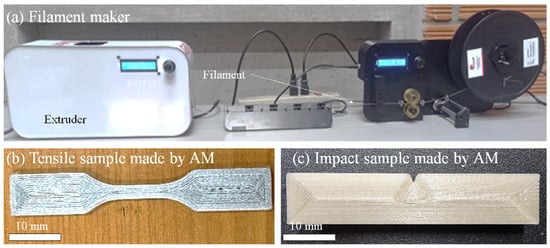
Figure 1
Open AccessArticle
Physicochemical and Rheological Properties of Succinoglycan Overproduced by Sinorhizobium meliloti 1021 Mutant
Polymers 2024, 16(2), 244; https://doi.org/10.3390/polym16020244 - 15 Jan 2024
Abstract
Commercial bacterial exopolysaccharide (EPS) applications have been gaining interest; therefore, strains that provide higher yields are required for industrial-scale processes. Succinoglycan (SG) is a type of bacterial anionic exopolysaccharide produced by Rhizobium, Agrobacterium, and other soil bacterial species. SG has been
[...] Read more.
Commercial bacterial exopolysaccharide (EPS) applications have been gaining interest; therefore, strains that provide higher yields are required for industrial-scale processes. Succinoglycan (SG) is a type of bacterial anionic exopolysaccharide produced by Rhizobium, Agrobacterium, and other soil bacterial species. SG has been widely used as a pharmaceutical, cosmetic, and food additive based on its properties as a thickener, texture enhancer, emulsifier, stabilizer, and gelling agent. An SG-overproducing mutant strain (SMC1) was developed from Sinorhizobium meliloti 1021 through N-methyl-N′-nitro-N-nitrosoguanidine (NTG) mutation, and the physicochemical and rheological properties of SMC1-SG were analyzed. SMC1 produced (22.3 g/L) 3.65-fold more SG than did the wild type. Succinoglycan (SMC1-SG) overproduced by SMC1 was structurally characterized by FT-IR and 1H NMR spectroscopy. The molecular weights of SG and SMC1-SG were 4.20 × 105 and 4.80 × 105 Da, respectively, as determined by GPC. Based on DSC and TGA, SMC1-SG exhibited a higher endothermic peak (90.9 °C) than that of SG (77.2 °C). Storage modulus (G′) and loss modulus (G″) measurements during heating and cooling showed that SMC1-SG had improved thermal behavior compared to that of SG, with intersections at 74.9 °C and 72.0 °C, respectively. The SMC1-SG′s viscosity reduction pattern was maintained even at high temperatures (65 °C). Gelation by metal cations was observed in Fe3+ and Cr3+ solutions for both SG and SMC1-SG. Antibacterial activities of SG and SMC1-SG against Escherichia coli and Staphylococcus aureus were also observed. Therefore, like SG, SMC1-SG may be a potential biomaterial for pharmaceutical, cosmetic, and food industries.
Full article
(This article belongs to the Special Issue Feature Papers in Biomacromolecules, Biobased and Biodegradable Polymers, 3rd Edition)
►▼
Show Figures
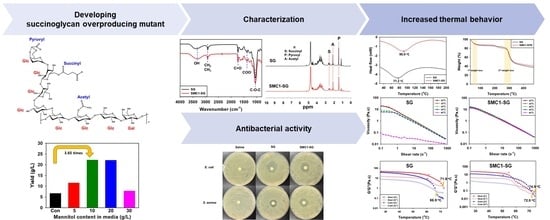
Graphical abstract
Open AccessArticle
The Interconnecting Process and Sensing Performance of Stretchable Hybrid Electronic Yarn for Body Temperature Monitoring
Polymers 2024, 16(2), 243; https://doi.org/10.3390/polym16020243 - 15 Jan 2024
Abstract
Flexible and stretchable electronic yarn containing electronic components (i.e., hybrid electronic yarn) are essential for manufacturing smart textile garments or fabrics. Due to their low stretchability and easy interconnection fracture, previously reported hybrid electronic sensing yarns have poor mechanical durability and washability. In
[...] Read more.
Flexible and stretchable electronic yarn containing electronic components (i.e., hybrid electronic yarn) are essential for manufacturing smart textile garments or fabrics. Due to their low stretchability and easy interconnection fracture, previously reported hybrid electronic sensing yarns have poor mechanical durability and washability. In order to address this issue, a stretchable hybrid electronic yarn for body temperature monitoring was designed and prepared using a spandex filament as the core yarn and a thin enameled copper wire connected with a thermal resistor as the wrapping fiber. The temperature sensing performance of different hybrid electronic yarn samples was evaluated using the following three types of interconnection methods: conductive adhesive bonding, melt soldering, and hot pressure bonding. The optimal interconnection method with good sensing performance was determined. Furthermore, in order to improve the mechanical durability of the hybrid electronic yarn made using the optimal interconnection method, the interconnection area was encapsulated with polymers, and the effect of polymer materials and structures on the temperature-sensing properties was evaluated. The results show that traditional wrapping combined with hot pressing interconnection followed by tube encapsulating technology is beneficial for achieving high stretchability and good temperature-sensing performance of hybrid electronic yarn.
Full article
(This article belongs to the Special Issue Smart Textiles: Synthesis, Characterization and Application)
►▼
Show Figures

Figure 1
Open AccessArticle
Aloe vera/Chitosan-Based Edible Film with Enhanced Antioxidant, Antimicrobial, Thermal, and Barrier Properties for Sustainable Food Preservation
by
, , , , and
Polymers 2024, 16(2), 242; https://doi.org/10.3390/polym16020242 - 15 Jan 2024
Abstract
Food bioactive packaging has received increasing attention from consumers and the food industry for its potential to reduce food waste and environmental issues. Several materials can be used to produce edible films/coats; however, bio-based, cost-effective, and sustainable coatings have gained a high reputation
[...] Read more.
Food bioactive packaging has received increasing attention from consumers and the food industry for its potential to reduce food waste and environmental issues. Several materials can be used to produce edible films/coats; however, bio-based, cost-effective, and sustainable coatings have gained a high reputation these days. For instance, Aloe vera gel (AV) is a promising bio-based material for edible coatings and films; therefore, the present study aimed to investigate the film-forming abilities of AV and Chitosan (CH) combination as a potential active food packaging material. The physicochemical and mechanical characteristics of formed films of various combinations were prepared at different concentrations, i.e., CH (0.5% w/v), AV (100%), CH:AV (75:25), and CH:AV (60:40). The results showed significant differences among all the prepared edible films wherein these differences were mainly on account of incorporating AV gel. The rheological and antioxidant properties of the formulations improved with the inclusion of AV gel. The films composed of CH:AV (60:40) positively affected the water solubility, thermal properties, and water vapour permeability of the edible films. The X-ray Diffraction (XRD) and Scanning electron microscopy (SEM) results showed that the films composed of CH:AV, (60:40) were amorphous and had smooth morphology. Further, the edible film solutions were applied to fresh figs (Ficus carica) to investigate their role in preserving fruits during storage. A significant reduction in microbial growth was found in coated fruits after 28 days of cold storage. The films composed of CH and AV showed overall improved results compared to the CH (0.5%, w/v). Therefore, the used formulations (CH:AV, 60:40) can form a sustainable film that has the potential to be utilized for fresh product preservation to maintain its quality and shelf life.
Full article
(This article belongs to the Special Issue Chitosan-Based Coatings for Food, Pharmaceutical and Medical Applications)
►▼
Show Figures

Figure 1
Open AccessArticle
Preparation and Characterization of Acrylic and Methacrylic Phospholipid-Mimetic Polymer Hydrogels and Their Applications in Optical Tissue Clearing
Polymers 2024, 16(2), 241; https://doi.org/10.3390/polym16020241 - 15 Jan 2024
Abstract
The 2-methacryloyloxyethyl phosphorylcholine (MPC) polymers are mimetic to phospholipids, being widely used as biocompatible polymers. In our previous study, MPC polymer hydrogels proved more effective for optical tissue clearing compared to acrylamide (AAm) polymer hydrogels. In the present study, 2-acryloyloxyethyl phosphorylcholine (APC) was
[...] Read more.
The 2-methacryloyloxyethyl phosphorylcholine (MPC) polymers are mimetic to phospholipids, being widely used as biocompatible polymers. In our previous study, MPC polymer hydrogels proved more effective for optical tissue clearing compared to acrylamide (AAm) polymer hydrogels. In the present study, 2-acryloyloxyethyl phosphorylcholine (APC) was synthesized and employed to create hydrogels for a comparative analysis with methacrylic MPC-based hydrogels. APC, an acrylic monomer, was copolymerized with AAm in a similar reactivity. In contrast, MPC, as a methacrylic monomer, demonstrated higher copolymerization reactivity than AAm, leading to a spontaneously delayed two-step polymerization behavior. This suggests that the polymer sequences and network structures became heterogeneous when both methacrylic and acrylic monomers, as well as crosslinkers, were present in the copolymerization system. The molecular weight of the APC polymers was considerably smaller than that of the MPC polymers due to the formation of mid-chain radicals and subsequent β-scission during polymerization. The swelling ratios in water and strain sweep profiles of hydrogels prepared using acrylic and methacrylic compounds differed from those of hydrogels prepared using only acrylic compounds. This implies that copolymerization reactivity influences the polymer network structures and crosslinking density in addition to the copolymer composition. APC-based hydrogels are effective for the optical clearing of tumor tissues and are applicable to both passive and electrophoretic methods.
Full article
(This article belongs to the Special Issue Feature Papers in Polymer Applications II)
►▼
Show Figures
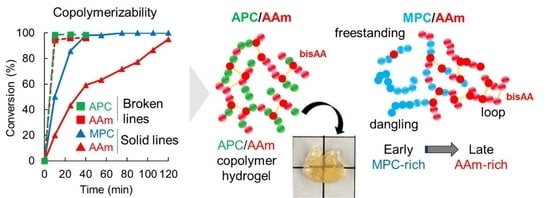
Graphical abstract
Open AccessArticle
Atmospheric Pressure Plasma Jet Exposure of Polylactic Acid Surfaces for Better Adhesion: Plasma Parameters towards Polymer Properties
by
, , , , , and
Polymers 2024, 16(2), 240; https://doi.org/10.3390/polym16020240 - 15 Jan 2024
Abstract
►▼
Show Figures
Polymers play a crucial role in multiple industries; however, surface modification is necessary for certain applications. Exposure to non-thermal plasma provides a viable and environmentally beneficial option. Fused deposition molding utilizes biodegradable polylactic acid, although it encounters constraints in biomedical applications as a
[...] Read more.
Polymers play a crucial role in multiple industries; however, surface modification is necessary for certain applications. Exposure to non-thermal plasma provides a viable and environmentally beneficial option. Fused deposition molding utilizes biodegradable polylactic acid, although it encounters constraints in biomedical applications as a result of inadequate mechanical characteristics. This study investigates the effects of atmospheric pressure plasma generated by a dielectric barrier discharge system using helium and/or argon on the modification of polylactic acid surfaces, changes in their wettability properties, and alterations in their chemical composition. The plasma source was ignited in either He or Ar and was tailored to fit the best operational conditions for polymer exposure. The results demonstrated the enhanced wettability of the polymer surface following plasma treatment (up to 40% in He and 20% in Ar), with a marginal variation observed among treatments utilizing different gases. The plasma treatments also caused changes in the surface topography, morphology, roughness, and hydrophilicity. Plasma exposure also resulted in observable modifications in the dielectric characteristics, phase transition, and structure. The experimental findings endorse the utilization of plasma technologies at normal air pressure for environmentally friendly processing of polymer materials, specifically for applications that necessitate enhanced adhesion and have carefully selected prerequisites.
Full article
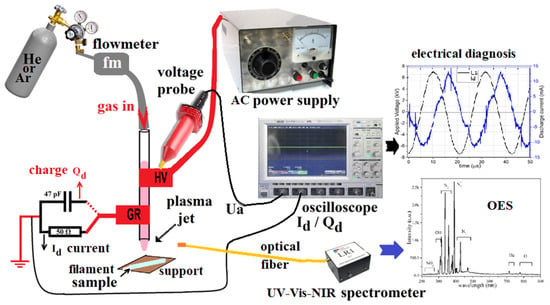
Figure 1
Open AccessArticle
Preparation of Protein A Membranes Using Propargyl Methacrylate-Based Copolymers and Copper-Catalyzed Alkyne–Azide Click Chemistry
by
and
Polymers 2024, 16(2), 239; https://doi.org/10.3390/polym16020239 - 15 Jan 2024
Abstract
The development of convective technologies for antibody purification is of interest to the bioprocessing industries. This study developed a Protein A membrane using a combination of graft polymerization and copper(I)-catalyzed alkyne–azide click chemistry. Regenerated cellulose supports were functionalized via surface-initiated copolymerization of propargyl
[...] Read more.
The development of convective technologies for antibody purification is of interest to the bioprocessing industries. This study developed a Protein A membrane using a combination of graft polymerization and copper(I)-catalyzed alkyne–azide click chemistry. Regenerated cellulose supports were functionalized via surface-initiated copolymerization of propargyl methacrylate (PgMA) and poly(ethylene glycol) methyl ether methacrylate (PEGMEMA300), followed by a reaction with azide-functionalized Protein A ligand. The polymer-modified membranes were characterized using attenuated total reflectance Fourier-transform infrared spectroscopy (ATR-FTIR), gravimetric analysis, and permeability measurements. Copolymer composition was determined using the Mayo–Lewis equation. Membranes clicked with azide-conjugated Protein A were evaluated by measuring static and dynamic binding (DBC10) capacities for human immunoglobulin G (hIgG). Copolymer composition and degree of grafting were found to affect maximum static binding capacities, with values ranging from 5 to 16 mg/mL. DBC10 values did not vary with flow rate, as expected of membrane adsorbers.
Full article
(This article belongs to the Section Polymer Chemistry)
►▼
Show Figures

Graphical abstract
Open AccessArticle
Welded Carbon Nanotube–Graphene Hybrids with Tunable Strain Sensing Behavior for Wide-Range Bio-Signal Monitoring
Polymers 2024, 16(2), 238; https://doi.org/10.3390/polym16020238 - 15 Jan 2024
Abstract
Carbon nanotubes (CNTs) and graphene have commonly been applied as the sensitive layer of strain sensors. However, the buckling deformation of CNTs and the crack generation of graphene usually leads to an unsatisfactory strain sensing performance. In this work, we developed a universal
[...] Read more.
Carbon nanotubes (CNTs) and graphene have commonly been applied as the sensitive layer of strain sensors. However, the buckling deformation of CNTs and the crack generation of graphene usually leads to an unsatisfactory strain sensing performance. In this work, we developed a universal strategy to prepare welded CNT–graphene hybrids with tunable compositions and a tunable bonding strength between components by the in situ reduction of CNT–graphene oxide (GO) hybrid by thermal annealing. The stiffness of the hybrid film could be tailored by both initial CNT/GO dosage and annealing temperature, through which its electromechanical behaviors could also be defined. The strain sensor based on the CNT–graphene hybrid could be applied to collect epidermal bio-signals by both capturing the faint skin deformation from wrist pulse and recording the large deformations from joint bending, which has great potential in health monitoring, motion sensing and human–machine interfacing.
Full article
(This article belongs to the Special Issue Application of Artificial Intelligence in Polymer Composite Materials Research)
►▼
Show Figures

Graphical abstract
Open AccessArticle
Structure–Performance Correlation Inspired Platinum-Assisted Anode with a Homogeneous Ionomer Layer for Proton Exchange Membrane Water Electrolysis
Polymers 2024, 16(2), 237; https://doi.org/10.3390/polym16020237 - 15 Jan 2024
Abstract
PEMWE is becoming one of the most promising technologies for efficient and green hydrogen production, while the anode OER process is deeply restricted by the now commercially used iridium oxide with sluggish reaction kinetics and super high cost. Deeply exploring the essential relationship
[...] Read more.
PEMWE is becoming one of the most promising technologies for efficient and green hydrogen production, while the anode OER process is deeply restricted by the now commercially used iridium oxide with sluggish reaction kinetics and super high cost. Deeply exploring the essential relationship between the underlying substrate materials and the performance of PEMWE cells while simultaneously excavating new practical and convenient methods to reduce costs and increase efficiency is full of challenges. Herein, two representative kinds of iridium oxide were studied, and their performance difference in PEMWE was precisely analyzed with electrochemical techniques and physical characterization and further linked to the ionomer/catalyst compound features. A novel anode with a uniform thin ionomer coating was successfully constructed, which simultaneously optimized the ionomer/catalyst aggregates as well as electrical conductivity, resulting in significantly enhanced PEMWE performance. This rigorous qualitative analysis of the structure–performance relationship as well as effective ionomer-affinitive optimization strategies are of great significance to the development of next-generation high-performance PEM water electrolyzers.
Full article
(This article belongs to the Special Issue Feature Papers in Polymer Applications II)
►▼
Show Figures
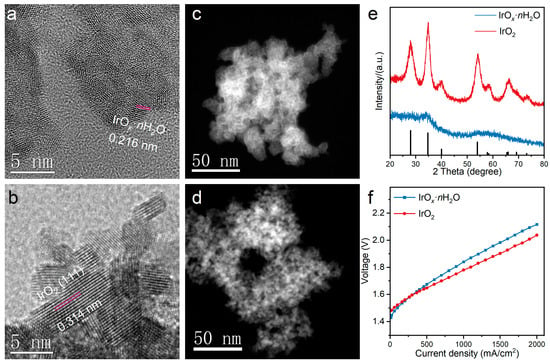
Figure 1
Open AccessArticle
Copolymerization of Ethylene with Functionalized 1,1-Disubstituted Olefins Using a Fluorenylamido-Ligated Titanium Catalyst
Polymers 2024, 16(2), 236; https://doi.org/10.3390/polym16020236 - 15 Jan 2024
Abstract
Considering the sustainability of material development, coordination polymerization catalysts effective for 1,1-disubstituted olefins are receiving a great deal of attention because they can introduce a variety of plant-derived comonomers, such as β-pinene and limonene, into polyolefins. However, due to their sterically encumbered property,
[...] Read more.
Considering the sustainability of material development, coordination polymerization catalysts effective for 1,1-disubstituted olefins are receiving a great deal of attention because they can introduce a variety of plant-derived comonomers, such as β-pinene and limonene, into polyolefins. However, due to their sterically encumbered property, incorporating these monomers is difficult. Herein, we succeeded in the copolymerization of ethylene with various hydroxy- or siloxy-substituted vinylidenes using a fluorenylamido-ligated titanium catalyst–MMAO system. This is the first example of ethylene/polar 1,1-disubstituted olefins’ copolymerization using an early transition metal catalyst system. The polymerization proceeded at room temperature without pressurizing ethylene, and high-molecular-weight, functionalized polyethylene was obtained. The obtained copolymer showed a reduced water contact angle compared with that of the ethylene/isobutene copolymer, demonstrating the increment in hydrophilicity by hydroxy groups.
Full article
(This article belongs to the Special Issue Catalytic Olefin Polymerization and Polyolefin Materials)
►▼
Show Figures

Graphical abstract
Open AccessArticle
Efficient Regulation of the Cross-Linking Structure in Polyurethane: Achieving Outstanding Processing and Mechanical Properties for a Wind Turbine Blade
Polymers 2024, 16(2), 235; https://doi.org/10.3390/polym16020235 - 15 Jan 2024
Abstract
Although epoxy resin has been extensively used in the field of wind turbine blades, polyurethane has attracted much attention in recent years, due to its potential value of better fatigue resistance, lower processing viscosity and higher strength than epoxy resin blades. Herein, we
[...] Read more.
Although epoxy resin has been extensively used in the field of wind turbine blades, polyurethane has attracted much attention in recent years, due to its potential value of better fatigue resistance, lower processing viscosity and higher strength than epoxy resin blades. Herein, we construct a dense cross-linking structure in polyurethane (PU) based on different amounts of hydroxypropyl methacrylate (HPMA) with low processing viscosity and excellent mechanical properties. By increasing the content of HPMA, the thermal stability of PU is enhanced, but the micro-morphology does not change significantly. When the content of HPMA is 50 g (in 200 g copolymer), the PU sample PH-50 exhibits a viscosity of 70 MPa·s and a gelation time of 120 min at 25 °C, which is sufficient to complete processes like pouring and filling. By post-curing the PH-50 at 80 °C for 2 h, the heat distortion temperature can reach 72 °C, indicating the increase of temperature resistance. The PU copolymers also have excellent mechanical and dynamic thermo-mechanical properties due to the cross-linking structure between PU chains and poly-HPMA chains. Additionally, the PU copolymer has excellent compatibility with various glass fiber fabrics (GFF), showing a good match in the vacuum infusion experiment and great properties in the mechanical test. By compounding PH-50 with GFF, the composite with high strength is easily prepared for a wind turbine blade in various positions. The tensile strengths of the composites are all over 1000 MPa in the 0° direction. Such composites are promising for the future development of wind turbine blades that meet the stringent requirements for outstanding processing and mechanical properties.
Full article
(This article belongs to the Special Issue Mechanical Properties of Polymer Composites II)
►▼
Show Figures

Figure 1
Open AccessArticle
A Spike-like Self-Assembly of Polyaspartamide Integrated with Functionalized Nanoparticles
Polymers 2024, 16(2), 234; https://doi.org/10.3390/polym16020234 - 15 Jan 2024
Abstract
The integration of nanoparticles (NPs) into molecular self-assemblies has been extensively studied with the aim of building well-defined, ordered structures which exhibit advanced properties and performances. This study demonstrates a novel strategy for the preparation of a spike-like self-assembly designed to enhance UV
[...] Read more.
The integration of nanoparticles (NPs) into molecular self-assemblies has been extensively studied with the aim of building well-defined, ordered structures which exhibit advanced properties and performances. This study demonstrates a novel strategy for the preparation of a spike-like self-assembly designed to enhance UV blocking. Poly(2-hydroxyethyl aspartamide) (PHEA) substituted with octadecyl chains and menthyl anthranilate (C18-M-PHEA) was successfully synthesized by varying the number of grafted groups to control their morphology and UV absorption. The in situ incorporation of polymerized rod-like TiO2 within the C18-M-PHEA self-aggregates generated spike-like self-assemblies (TiO2@C18-M-PHEA) with a chestnut burr structure in aqueous solution. The results showed that the spike-like self-assemblies integrated with TiO2 NPs exhibited a nine-fold increase in UV protection by simultaneous UV absorption and scattering compared with the pure TiO2 NPs formed via a bulk mixing process. This work provides a novel method for UV protection using self-assembling poly(amino acid)s derivatives integrated with functional nanoparticles to tune their morphology and organization.
Full article
(This article belongs to the Special Issue Advances in Biopolymers and Composites for Biomedical Applications)
►▼
Show Figures
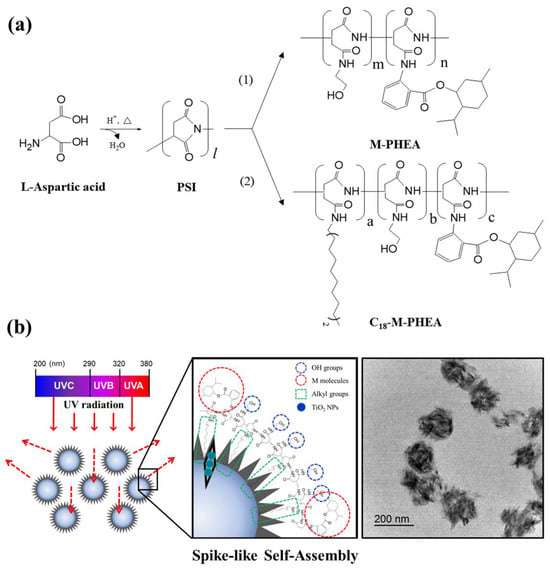
Figure 1
Open AccessArticle
The Domain and Structural Characteristics of Ferroelectric Copolymers Based on Vinylidene Fluoride Copolymer with Tetrafluoroethylene Composition (94/6)
by
, , , , , , and
Polymers 2024, 16(2), 233; https://doi.org/10.3390/polym16020233 - 15 Jan 2024
Abstract
This paper presents data on the macroscopic polarization of copolymer films of vinylidene fluoride with tetrafluoroethylene obtained with a modified apparatus assembled according to the Sawyer–Tower Circuit. The kinetics of the polarization process were analyzed taking into consideration the contributions of both bound
[...] Read more.
This paper presents data on the macroscopic polarization of copolymer films of vinylidene fluoride with tetrafluoroethylene obtained with a modified apparatus assembled according to the Sawyer–Tower Circuit. The kinetics of the polarization process were analyzed taking into consideration the contributions of both bound and quasi-free (impurity) charges. It was shown that an “abnormal” decrease in conductivity was observed in fields near the coercive fields. This could be associated with the appearance of deep traps of the impurity charge carriers formed by the polar planes of β-phase crystals. The conductivity data obtained from the charge and current responses differed. It was concluded that chain segments contributing to polarization with sufficiently low fields were present in the amorphous phase. A comparison showed that the average size of β-phase crystals (crystals of X-ray diffraction reflection width) was almost one order of magnitude lower than the domain size obtained using piezoresponse force microscopy (PFM). The analysis of the fast-stage dielectric response before and after polarization indicated that as the external polarizing field increased in the ferroelectric polymer chains, conformational transitions occurred according to the T3GT3G− → (-TT-)n и TGTG → (-TT-)n types. This was accompanied by an increase in the effective dipole moment in the amorphous phase chains. The analysis of the IR spectroscopy data obtained in transmission and ATR modes revealed a difference in the conformational states of the chains in the core and surface parts of the film.
Full article
(This article belongs to the Special Issue Stimuli-Responsive Polymers)
►▼
Show Figures

Figure 1
Open AccessArticle
Sustainable Materials with Improved Biodegradability and Toughness from Blends of Poly(Lactic Acid), Pineapple Stem Starch and Modified Natural Rubber
Polymers 2024, 16(2), 232; https://doi.org/10.3390/polym16020232 - 14 Jan 2024
Abstract
Poly(lactic acid) (PLA), derived from renewable resources, plays a significant role in the global biodegradable plastic market. However, its widespread adoption faces challenges, including high brittleness, hydrophobicity, limited biodegradability, and higher costs compared to traditional petroleum-based plastics. This study addresses these challenges by
[...] Read more.
Poly(lactic acid) (PLA), derived from renewable resources, plays a significant role in the global biodegradable plastic market. However, its widespread adoption faces challenges, including high brittleness, hydrophobicity, limited biodegradability, and higher costs compared to traditional petroleum-based plastics. This study addresses these challenges by incorporating thermoplastic pineapple stem starch (TPSS) and modified natural rubber (MNR) into PLA blends. TPSS, derived from pineapple stem waste, is employed to enhance hydrophilicity, biodegradability, and reduce costs. While the addition of TPSS (10 to 40 wt.%) marginally lowered mechanical properties due to poor interfacial interaction with PLA, the inclusion of MNR (1 to 10 wt.%) in the PLA/20TPSS blend significantly improved stretchability and impact strength, resulting in suitable modulus (1.3 to 1.7 GPa) and mechanical strength (32 to 52 MPa) for diverse applications. The presence of 7 wt.% MNR increased impact strength by 90% compared to neat PLA. The ternary blend exhibited a heterogeneous morphology with enhanced interfacial adhesion, confirmed by microfibrils and a rough texture on the fracture surface. Additionally, a downward shift in PLA’s glass transition temperature (Tg) by 5–6 °C indicated improved compatibility between components. Remarkably, the PLA ternary blends demonstrated superior water resistance and proper biodegradability compared to binary blends. These findings highlight the potential of bio-based plastics, such as PLA blends with TPSS and MNR, to contribute to sustainable economic models and reduce environmental impact for using in plastic packaging applications.
Full article
(This article belongs to the Special Issue Sustainability of Polymer Materials)
►▼
Show Figures
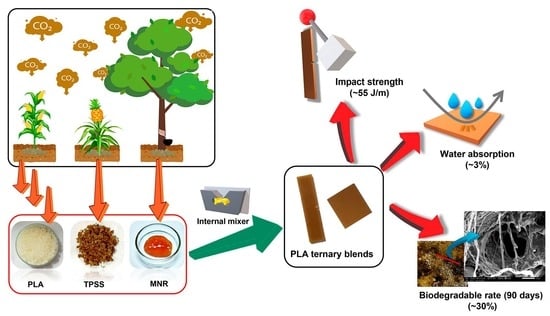
Graphical abstract
Open AccessArticle
Ameliorative Effects of Korean-Red-Ginseng-Derived Polysaccharide on Antibiotic-Associated Diarrhea
Polymers 2024, 16(2), 231; https://doi.org/10.3390/polym16020231 - 14 Jan 2024
Abstract
This study evaluated the ameliorative effects of Korean-red-ginseng-derived polysaccharide (KRG-P) on antibiotic-associated diarrhea (AAD) induced by administering lincomycin in mice. Changes of intestinal barrier proteins, the intestinal microbiome and short-chain fatty acid (SCFA) contents were investigated. Lincomycin was orally administered for 9 days
[...] Read more.
This study evaluated the ameliorative effects of Korean-red-ginseng-derived polysaccharide (KRG-P) on antibiotic-associated diarrhea (AAD) induced by administering lincomycin in mice. Changes of intestinal barrier proteins, the intestinal microbiome and short-chain fatty acid (SCFA) contents were investigated. Lincomycin was orally administered for 9 days to induce diarrhea; subsequently, 100 mg/kg and 300 mg/kg of KRG-P were administered orally for 12 days. The diarrhea was observed in the AAD group; further KRG-P administration improved the diarrhea. Analysis of changes in the intestinal microbial flora of the mice revealed that the harmful bacterial flora (such as Proteobacteria) were increased in the AAD group, whereas beneficial bacterial flora (such as Firmicutes) were decreased. However, KRG-P administration resulted in decreased Proteobacteria and increased Firmicutes, supporting the improvement of the microbial flora imbalance caused by AAD. Moreover, an analysis of the SCFAs (acetic acid, propionic acid, and butylic acid) in the caecum revealed that SCFAs’ contents in the AAD group were substantially reduced but tended to increase upon KRG-P administration. Based on these results, KRG-P, which is primarily composed of carbohydrates can improve lincomycin-induced diarrhea, likely owing to the recovery of SCFA content by improving the intestinal microbial imbalance and intestinal barrier proteins.
Full article
(This article belongs to the Special Issue Biopolymers for Medicinal, Macromolecules, and Food Applications III)
►▼
Show Figures
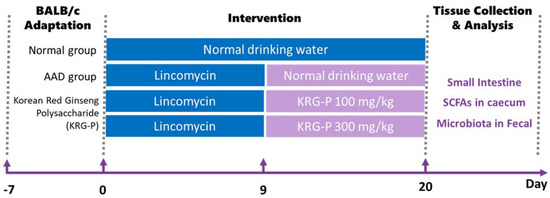
Figure 1
Open AccessReview
Cold Plasma Technology Based Eco-Friendly Food Packaging Biomaterials
Polymers 2024, 16(2), 230; https://doi.org/10.3390/polym16020230 - 14 Jan 2024
Abstract
Biopolymers have intrinsic drawbacks compared to traditional plastics, such as hydrophilicity, poor thermo-mechanical behaviours, and barrier characteristics. Therefore, biopolymers or their film modifications offer a chance to create packaging materials with specified properties. Cold atmospheric plasma (CAP) or Low temperature plasma (LTP) has
[...] Read more.
Biopolymers have intrinsic drawbacks compared to traditional plastics, such as hydrophilicity, poor thermo-mechanical behaviours, and barrier characteristics. Therefore, biopolymers or their film modifications offer a chance to create packaging materials with specified properties. Cold atmospheric plasma (CAP) or Low temperature plasma (LTP) has a wide range of applications and has recently been used in the food industry as a potent tool for non-thermal food processing. Though its original purpose was to boost polymer surface energy for better adherence and printability, it has since become an effective technique for surface decontamination of food items and food packaging materials. These revolutionary innovative food processing methods enable the balance between the economic constraints and higher quality while ensuring food stability and minimal processing. For CAP to be considered as a viable alternative food processing technology, it must positively affect food quality. Food products may have their desired functional qualities by adjusting the conditions for cold plasma formation. Cold plasma is a non-thermal method that has little effects on the treated materials and is safe for the environment. In this review, we focus on recent cold plasma advances on various food matrices derived from plants and animals with the aim of highlighting potential applications, ongoing research, and market trends.
Full article
(This article belongs to the Special Issue New Progress in Polymer Materials for Food Packaging)
►▼
Show Figures
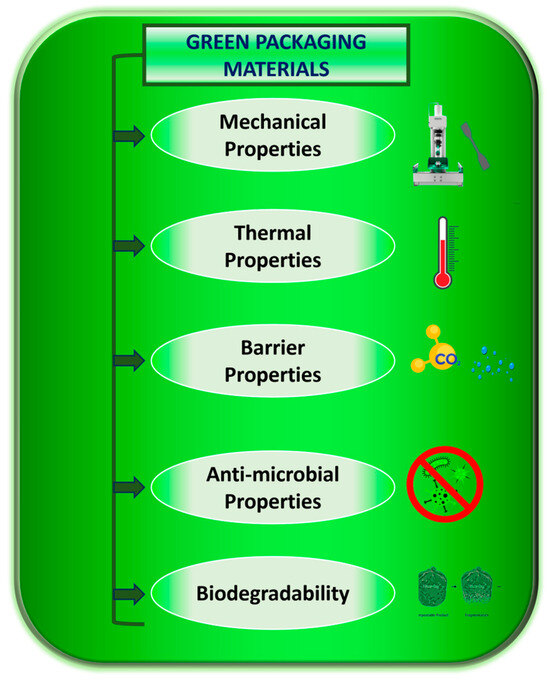
Figure 1

Journal Menu
► ▼ Journal Menu-
- Polymers Home
- Aims & Scope
- Editorial Board
- Reviewer Board
- Topical Advisory Panel
- Instructions for Authors
- Special Issues
- Topics
- Sections & Collections
- Article Processing Charge
- Indexing & Archiving
- Editor’s Choice Articles
- Most Cited & Viewed
- Journal Statistics
- Journal History
- Journal Awards
- Society Collaborations
- Conferences
- Editorial Office
Journal Browser
► ▼ Journal BrowserHighly Accessed Articles
Latest Books
E-Mail Alert
News
Topics
Topic in
IJMS, Materials, Nanomaterials, Pharmaceutics, Polymers
Nanomaterials and Polymers in Controlled Drug Delivery
Topic Editors: Ziyad S. Haidar, Prabir PatraDeadline: 31 January 2024
Topic in
C, Catalysts, Materials, Molecules, Nanomaterials, Polymers
Functional Adsorbents
Topic Editors: Krisztina László, Diána Balogh-Weiser, Tamás PardyDeadline: 29 February 2024
Topic in
Materials, Nanomaterials, Photonics, Polymers, Applied Sciences, Sensors
Optical and Optoelectronic Properties of Materials and Their Applications
Topic Editors: Zhiping Luo, Gibin George, Navadeep ShrivastavaDeadline: 20 May 2024
Topic in
Biomedicines, Cancers, JFB, Nanomaterials, Polymers
Advanced Functional Materials for Regenerative Medicine
Topic Editors: Antonino Morabito, Luca ValentiniDeadline: 6 June 2024

Conferences
Special Issues
Special Issue in
Polymers
Recent Study in Engineering Application of Microplastics and Nano Plastics
Guest Editors: Francesca Lionetto, Carlos Espinoza-GonzálezDeadline: 20 January 2024
Special Issue in
Polymers
Advances in Polymer Matrix Composites: Synthesis, Characterization and Simulation
Guest Editor: Albertino ArteiroDeadline: 31 January 2024
Special Issue in
Polymers
Develop Antimicrobial Polymer Textiles for Medical Applications
Guest Editor: Chi-Wai KanDeadline: 15 February 2024
Special Issue in
Polymers
Electrospinning Technology to Produce Innovative Nanostructured Polymer Materials: Current Applications and Future Perspectives
Guest Editors: Maila Castellano, Andrea Dodero, Silvia ViciniDeadline: 25 February 2024
Topical Collections
Topical Collection in
Polymers
Progress in Theory of Polymers at Interfaces
Collection Editors: Jens-Uwe Sommer, Martin Kröger
Topical Collection in
Polymers
State-of-the-Art Polymer Science and Technology in Poland (2021,2022)
Collection Editors: Marek M. Kowalczuk, Mirosława El Fray, Łukasz Klapiszewski, Dorota Neugebauer, Michał Cegłowski
Topical Collection in
Polymers
Proteins and Peptides
Collection Editors: Horia Iovu, Vladimir N. Uversky















